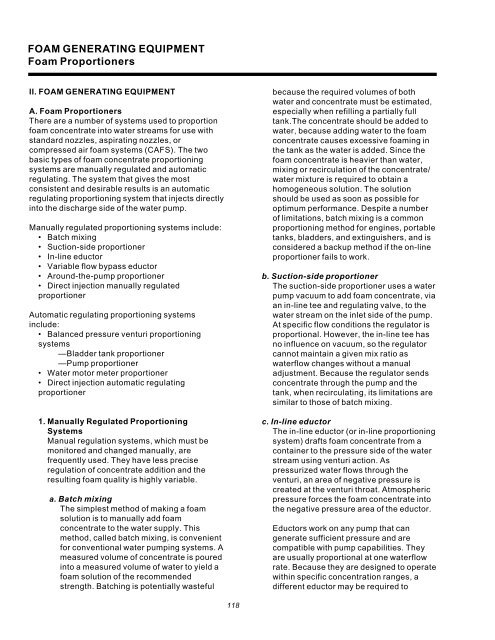Water Handling Equipment Guide - National Wildfire Coordinating ...
Water Handling Equipment Guide - National Wildfire Coordinating ...
Water Handling Equipment Guide - National Wildfire Coordinating ...
Create successful ePaper yourself
Turn your PDF publications into a flip-book with our unique Google optimized e-Paper software.
FOAM GENERATING EQUIPMENT<br />
Foam Proportioners<br />
II. FOAM GENERATING EQUIPMENT<br />
A. Foam Proportioners<br />
There are a number of systems used to proportion<br />
foam concentrate into water streams for use with<br />
standard nozzles, aspirating nozzles, or<br />
compressed air foam systems (CAFS). The two<br />
basic types of foam concentrate proportioning<br />
systems are manually regulated and automatic<br />
regulating. The system that gives the most<br />
consistent and desirable results is an automatic<br />
regulating proportioning system that injects directly<br />
into the discharge side of the water pump.<br />
Manually regulated proportioning systems include:<br />
• Batch mixing<br />
• Suction-side proportioner<br />
• In-line eductor<br />
• Variable flow bypass eductor<br />
• Around-the-pump proportioner<br />
• Direct injection manually regulated<br />
proportioner<br />
Automatic regulating proportioning systems<br />
include:<br />
• Balanced pressure venturi proportioning<br />
systems<br />
—Bladder tank proportioner<br />
—Pump proportioner<br />
• <strong>Water</strong> motor meter proportioner<br />
• Direct injection automatic regulating<br />
proportioner<br />
1. Manually Regulated Proportioning<br />
Systems<br />
Manual regulation systems, which must be<br />
monitored and changed manually, are<br />
frequently used. They have less precise<br />
regulation of concentrate addition and the<br />
resulting foam quality is highly variable.<br />
a. Batch mixing<br />
The simplest method of making a foam<br />
solution is to manually add foam<br />
concentrate to the water supply. This<br />
method, called batch mixing, is convenient<br />
for conventional water pumping systems. A<br />
measured volume of concentrate is poured<br />
into a measured volume of water to yield a<br />
foam solution of the recommended<br />
strength. Batching is potentially wasteful<br />
because the required volumes of both<br />
water and concentrate must be estimated,<br />
especially when refilling a partially full<br />
tank.The concentrate should be added to<br />
water, because adding water to the foam<br />
concentrate causes excessive foaming in<br />
the tank as the water is added. Since the<br />
foam concentrate is heavier than water,<br />
mixing or recirculation of the concentrate/<br />
water mixture is required to obtain a<br />
homogeneous solution. The solution<br />
should be used as soon as possible for<br />
optimum performance. Despite a number<br />
of limitations, batch mixing is a common<br />
proportioning method for engines, portable<br />
tanks, bladders, and extinguishers, and is<br />
considered a backup method if the on-line<br />
proportioner fails to work.<br />
b. Suction-side proportioner<br />
The suction-side proportioner uses a water<br />
pump vacuum to add foam concentrate, via<br />
an in-line tee and regulating valve, to the<br />
water stream on the inlet side of the pump.<br />
At specific flow conditions the regulator is<br />
proportional. However, the in-line tee has<br />
no influence on vacuum, so the regulator<br />
cannot maintain a given mix ratio as<br />
waterflow changes without a manual<br />
adjustment. Because the regulator sends<br />
concentrate through the pump and the<br />
tank, when recirculating, its limitations are<br />
similar to those of batch mixing.<br />
c. In-line eductor<br />
The in-line eductor (or in-line proportioning<br />
system) drafts foam concentrate from a<br />
container to the pressure side of the water<br />
stream using venturi action. As<br />
pressurized water flows through the<br />
venturi, an area of negative pressure is<br />
created at the venturi throat. Atmospheric<br />
pressure forces the foam concentrate into<br />
the negative pressure area of the eductor.<br />
Eductors work on any pump that can<br />
generate sufficient pressure and are<br />
compatible with pump capabilities. They<br />
are usually proportional at one waterflow<br />
rate. Because they are designed to operate<br />
within specific concentration ranges, a<br />
different eductor may be required to<br />
118
















